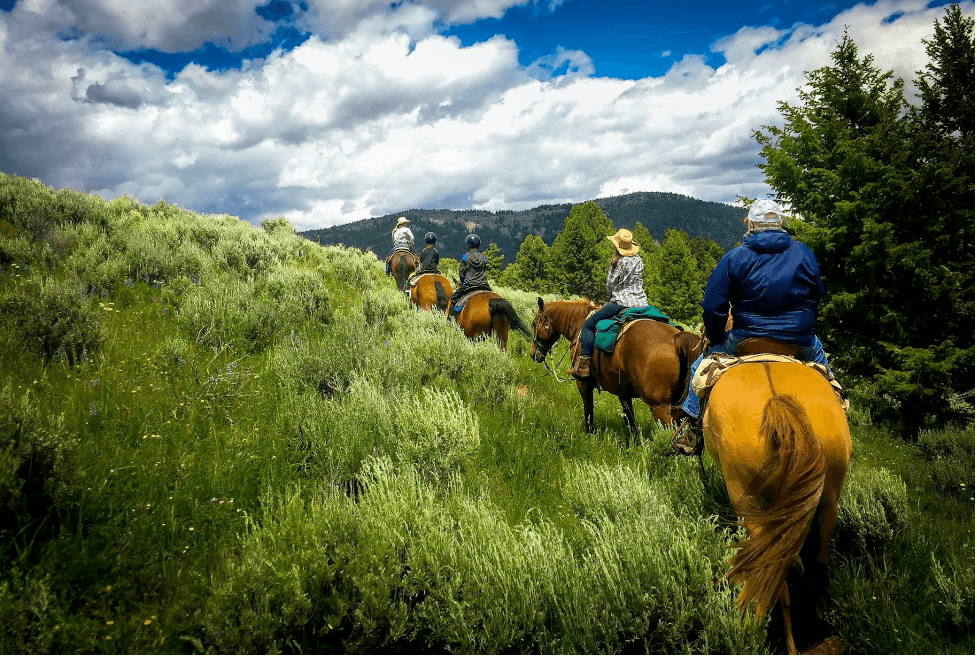Heading out on a trail ride is fun for you and your horse. It’s a relaxing break from the monotony of riding in the arena and a fun way to explore nature. Here are the top six items to pack for summer trail riding with your horse.
By Nicole McRay | Horse Safety Tips
Whether you go for a short ride on nearby trails or head out on a multi-day horseback riding adventure, a little preparation is key for both you and your horse. You’ll want to ensure that you have everything you need to meet your physical comforts and provide first aid if needed while you’re on the trail.
Of course, your needs will change depending on the weather and the length of your ride, too. Here’s a look at what you should pack for short horseback riding jaunts, plus a more extensive list for more adventurous trips.
Just the Essentials for Short Trail Rides
Here’s what you and your horse will need for short day rides.
- Water and Snacks
Water is a must, even on cool days. And when it’s hot out, you’ll need to drink even more water to avoid becoming overheated. Freezing a couple of water bottles ahead of time is a great way to keep cold drinking water with you on the trail.
If you’re going to be on the trail for more than a couple of hours, consider bringing some snacks or lunch. You can get a saddle pack with an insulated compartment to keep things cold. For shorter rides, a granola bar or some trail mix should do the trick.
Be sure to plan ahead for your horse too. He can graze when you take breaks or munch on hay when you’re hanging out by the trailer.
Check ahead to see natural water sources will be available along the trail. If not, be sure your horse has plenty of water to drink right before you head out and immediately when you get back. If it’s a hot day, it’s probably best to avoid trails that don’t have a natural water source.
- Fly Protection
If you’ve been around horses long, you already know what a nuisance flies can be. Be sure to spray your horse down with fly spray before you head out. If you can find one that repels mosquitos and other biting insects that’s even better.
Applying bug spray to yourself is probably a good idea, too. You might even want to bring along a travel-sized bottle, just in case you need to reapply along the way.
- Sunscreen and Lip Balm
Sunscreen is a must, even If you think you’ll be in the shade most of the time. The elements can be so tough on your skin and you’ll be glad you took the time at the end of the day.
When it comes to your horse, you can use a mineral-based, zinc oxide sunscreen cream to protect the delicate skin on the nose and ears. The pink skin in those areas can be especially sensitive to the sun.
- Your Cell Phone
Hitting the trail with your horse is a great way to unplug, but you should still keep your cell phone handy. Make sure it’s fully charged and programmed with emergency phone numbers before you leave.
Having your phone with you while riding is great if you need quick access to an animal health expert in the case of an emergency. Per the recommendation of veterinary technicians, online ask a veterinarian services are a great help if your horse gets injured on the trail.
Of course, it will give you a way to call for help if you become lost or injured, too. Downloading a tracking app onto your phone so that you can easily be found in case of emergency is also a good idea. A map app might also be helpful, especially if you’ll be riding through unfamiliar areas.
When you’re on the trail, carry the phone on your body, just in case you get separated from your horse somehow during your ride.
- A Small First Aid Kit
A small first aid kit should be a staple on any trail ride. Put one together that will meet your needs and your horse’s in a minor emergency. Keep it in your fanny pack or day bag so it’s always ready to go.
Here’s what to include:
- A hoof pick: An absolute essential in case your horse gets a stone in his hoof on the trail.
- Gauze: To cover wounds and help stop bleeding if one of you gets cut.
- Vet wrap: To keep the gauze in place until you make it back home.
- A small bottle of saline: For rinsing wounds
- Triple antibiotic ointment: For minor cuts and scrapes
- Self-adhesive bandages: For minor human boo-boos
- Tools for Minor Repairs on the Trail
You never know what’s going to happen on the trail, even if it’s one you’re super familiar with. Keeping a few small items for minor repairs on hand can be super helpful.
Here’s what we recommend:
- A pocket knife
- A shoelace or some baling twine to make temporary repairs to your bridle, reins, stirrup leathers, or other equipment until you can get home safely
- A bandana and safety pin can serve a variety of uses, including making temporary repairs to clothes and tack
Additional Items to Bring on Overnight Rides
In addition to the items listed above, you’ll want a few more things for overnight and multi-day rides. Of course, you’ll want to plan on enough food and water for both of you for as long as you’ll be out. In fact, it’s probably a good idea to bring a little extra, just in case you’re out longer than expected.
Be sure to check rules and regulations to see if grazing will be available. If not, you’ll want to bring the pellets and/or hay cubes your horse is used to eating. Horses can go through about 5-gallons of water per day, so plan ahead and keep a tank or jug in your horse trailer, too.
Aside from additional food and water, here are some other things to think about:
- A Lightweight Horse Blanket
Temperatures can drop quite a bit during the night, and the last thing you want is your horse getting chilled after a long ride. A lightweight horse blanket will keep him warm and it will help keep the bugs off of him, too.
- Grooming Tools
Some basic grooming tools, such as a soft body brush to remove dust and surface dirt and a rubber curry brush to remove dried mud, will be useful after a long day on the trail. If your horse gets into burs, a mane and tail brush might also come in handy.
- A Spare Halter and Lead Rope
Having a spare halter and lead rope is a good idea in case your horse breaks one. Make sure his halter is comfortable enough to wear when he’s tied, especially if it will be on him overnight.
- Clothes
Horseback riding attire, such as jeans, leather riding chaps, and boots, will help to keep your legs and feet from getting scraped up while you’re riding. Don’t make the mistake of wearing shorts! Saddles can get super hot in the sun and shorts won’t give you any protection against brambles and other pointy foliage along the way.
Whatever shirt you’re most comfortable in should be fine on top but consider bringing a lightweight jacket or hoodie for cool mornings and evenings. A hat with a brim and some sunglasses will keep you more comfortable once the sun starts blazing- and they’ll help keep the bugs away from your eyes, too.
It might be a good idea to bring along a rain poncho, too. That way you won’t end up sitting on your horse for hours in wet clothes if a shower comes up unexpectedly.
- Whistle, Map, Compass, and Survey Tape
Getting lost while you’re out trail riding isn’t going to be fun for anyone. Everyone in your group should carry a whistle when you’re out on the trail. That way you can find each other easily if someone gets separated.
Having a waterproof map of the area and a compass so you can find your way back to camp is also essential. Survey tape can also come in handy for marking the trail as you go so you know how to find your way back.
- A Hoof Boot
A hoof boot is kind of like a spare tire for your horse. If he throws a shoe, you can put the boot on to protect him from stones and other damage on the return ride. Be sure to try it on your horse ahead of time. You want it to fit snugly and securely on a shoeless hoof.
Some Final Tips
There are lots of fantastic accessories that will help you carry the essentials while you ride. For example, you can get water bottle holders that clip to your saddle. Western saddles with pommel bags or English saddles with cantle bags can keep other items within easy reach.
And finally, take the time to make sure your tack fits you and your horse correctly before you head out on your ride. This is important not only for your comfort and safety but also for preventing chafing on your horse as he moves over a variety of terrains.
RELATED: Camping Without a Pack Horse

News from the horse industry. Sharing today’s information as it happens. The Northwest Horse Source is not responsible for the content of 3rd party submissions.


